The beautiful city of Gdańsk, situated on Poland’s northern Baltic coast, is the site of two historically significant events of the twentieth century that affected the course of world history. Each one is so influential that it warrants a world-class museum. These and other budget-friendly things to do in Gdansk Poland make the city a worthy travel destination.
Table of Contents
- Budget-friendly things to do in Gdansk Poland
- (i) Free things to do in Gdansk
- 1. Soak up the impressive Old Town
- 2. Cruise Długi Targ and Ulica Długa
- 3. Examine the detail of Neptune’s Fountain
- 4. Strike out early
- 5. Pause by the Fahrenheit Monument
- 6. Wander up and down Mariacka Street
- 7. Step inside St Mary’s Church
- 8. Explore the alleyways and backstreets of the Old Town
- 9. Pay tribute to the defenders of the historical Gdańsk Post Office
- 10. Shop at Market Hall
- 11. Admire the Zuraw Crane
- 12. Explore both sides of the Motława River
- 13. Cross to Granary Island
- 14. Explore the area around the Love Bridge
- 15. Tour the Zaspa murals
- (ii) Inexpensive things to do in Gdansk
- 16. Visit Gdańsk Town Hall for the museum and tower views
- 17. Spend time at the European Solidarity Centre
- 18. Tour Gdańsk Shipyard on a historical Polish boat
- 19. Don’t miss the Museum of the Second World War
- 20. Take an electric scooter tour
- 21. Ride the AmberSky
- 22. Enjoy Polish delicacies
- 23. Visit the Amber Museum
- 24. Visit Malbork Castle on a day trip
- 25. Take a day trip to Gdynia and Sopot
- (i) Free things to do in Gdansk
- Conclusion
Budget-friendly things to do in Gdansk Poland
Gdańsk’s fabulous museums, the striking architecture of the Old Town, the variety of Polish cuisine enjoyed in a vibrant outdoor dining scene, and appealing day trips make Gdańsk a desirable place to visit. The following expansive list of budget-friendly things to do in Gdansk will help you explore this walkable city steeped in a rich and notable history.
(i) Free things to do in Gdansk
1. Soak up the impressive Old Town
Gdańsk, known as the Free City of Danzig between the two world wars, was administered by Poland. In 1939, the population was 90% German. With the city in ruins in 1945, a fierce post-war debate centred on three main choices: modern or historical reconstruction or preservation of ruins.

By the end of 1947, the decision was made to rebuild a traditional Old Town designed by Polish artisans and architects with primarily Dutch but also Italian and French influences. All references to German influences, such as the architectural styles and street names, were rejected and erased, with the result that today, the Old Town bears little resemblance to how it looked in 1939.
2. Cruise Długi Targ and Ulica Długa
Długi Targ (Long Market) and Ulica Długa (Long Street) stretch from Brama Złota, the Golden Gate, marking the western end of the pedestrian thoroughfare to the arches of Brama Zielona (Green Gate) on the edge of the waterfront. The thoroughfare was part of the Royal Way, where Polish kings would pass en route to their palace. Pause frequently to admire the rows of tall, slender buildings with bright, colourful facades decorated with hundreds of gargoyles.
Admire the unmissable Town Hall housing the historical museum, where it’s possible to climb to the bell tower for arresting views. Artus Court (Arthur’s Court, named after King Arthur) dates to the 14th century. It was a meeting and socializing venue for merchants and nobility. It’s now part of the Gdańsk History Museum.
In front is Neptune’s Fountain, the maritime city’s nod to the sea god.
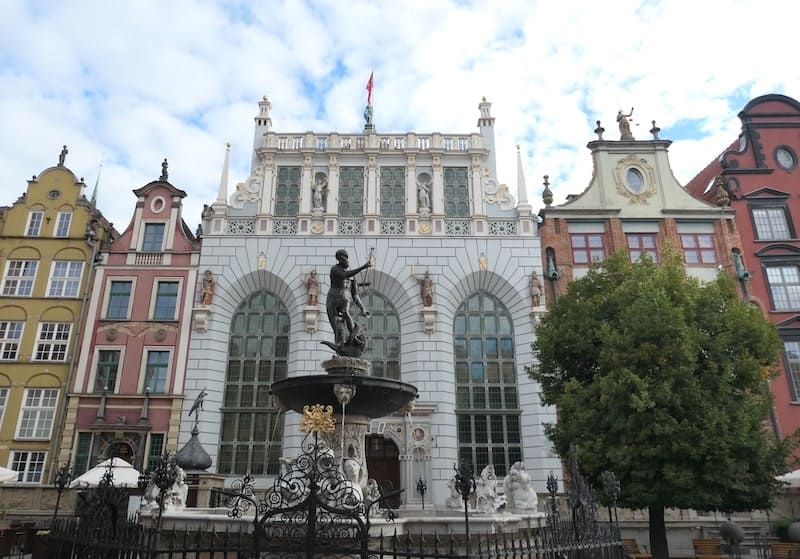
3. Examine the detail of Neptune’s Fountain
Neptune’s Fountain, sporting the bronze statue of the Roman God of the Sea, dates to 1549 before it became part of a fountain in 1633. On the basin beneath him are ornamental fish and cherubs.
Dismantled and hidden away for safekeeping during World War II, it was restored to its prominent place in the Old Town in 1954.
4. Strike out early
The Old Town can be crowded, predominantly late afternoons and evenings. However, early in the morning, the main 500-metre thoroughfare, Mariacka Street, and the riverside promenade are virtually people-free. It’s an ideal time to soak up the architecture and take photographs at your leisure.

5. Pause by the Fahrenheit Monument
Opposite Neptune’s Fountain is the Fahrenheit Monument, a glass-encased antique thermometer that honours Gdańsk native and pioneering temperature scientist Daniel Fahrenheit, creator of the Fahrenheit scale. Fahrenheit was born in Gdańsk in 1686. In 1724, his famous Fahrenheit Scale was completed. Despite the introduction of the Celsius scale, the Fahrenheit scale remains in use in several countries.

6. Wander up and down Mariacka Street
Charming Mariacka Street (Ulica Mariacka or St Mary’s Street) parallels Long Market, with St. Mary’s Church at one end and Mariacka Gate at the other. Its old Gdańsk-style architecture borders the cobblestone street, featuring rows of terraced houses decorated with gargoyles and narrow, richly ornamented facades. Gargoyles add interesting architectural elements connected to downpipes that spew water into the street when it rains.

The houses once belonged to wealthy merchants and goldsmiths. The street was severely damaged during World War II and reconstructed with salvaged materials scrounged from throughout the neighbourhood. Today, Mariacka is lined with amber shops and galleries. Amber is an orange or yellow stone, a fossilized resin from ancient trees, with the largest deposits in the Baltic Region.

7. Step inside St Mary’s Church
The Church of St. Mary, an impressive brick Gothic building from the 13th century, is the largest medieval brick church in Europe, accommodating 25,000 worshippers. Admire the high altar raised in the 1510s or climb the 405 steps to the bell tower for 360-degree city views.
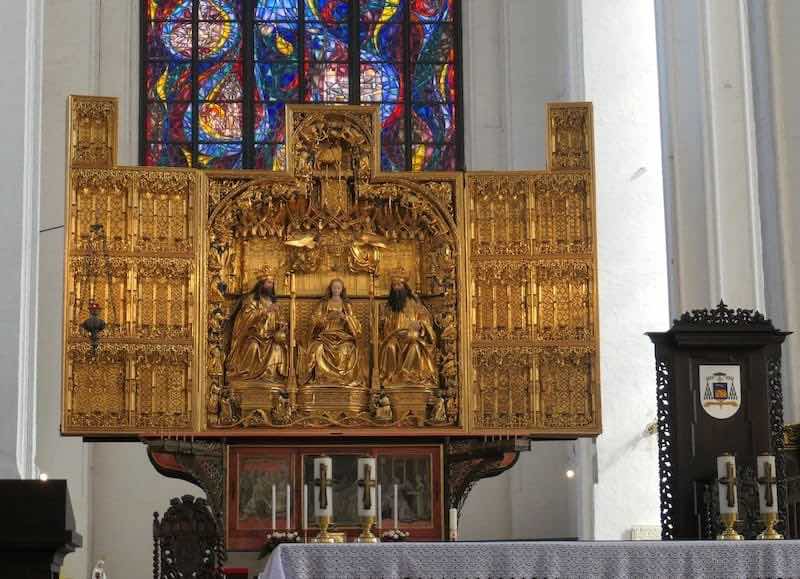
8. Explore the alleyways and backstreets of the Old Town
Leave the main thoroughfare of Długi Targ to stumble across remarkable architecture, churches, markets, statues, and eateries. With so many backstreets and alleyways, exploring Old Town is a delight.
Nearby Main Town has more pre-war buildings that didn’t suffer significant damage, yet some retain the scars of World War II on their façades.
9. Pay tribute to the defenders of the historical Gdańsk Post Office
On September 1, 1939, as detachments of German police and SS units lay siege to the post office, 50 Polish post office workers inside mounted a heroic struggle for over 17 hours until the casualties became unbearable, part of the building collapsed, and the Nazis attacked with flame-throwers. It is now a museum. Bullet holes and shrapnel damage on the façade are still visible, especially on the side of the building where the Polish prisoners were executed. Nearby is a stainless-steel Defenders of the Polish Post Monument, commissioned in 1979 and designed by the Kraków-based sculptor Wincenty Kućma.
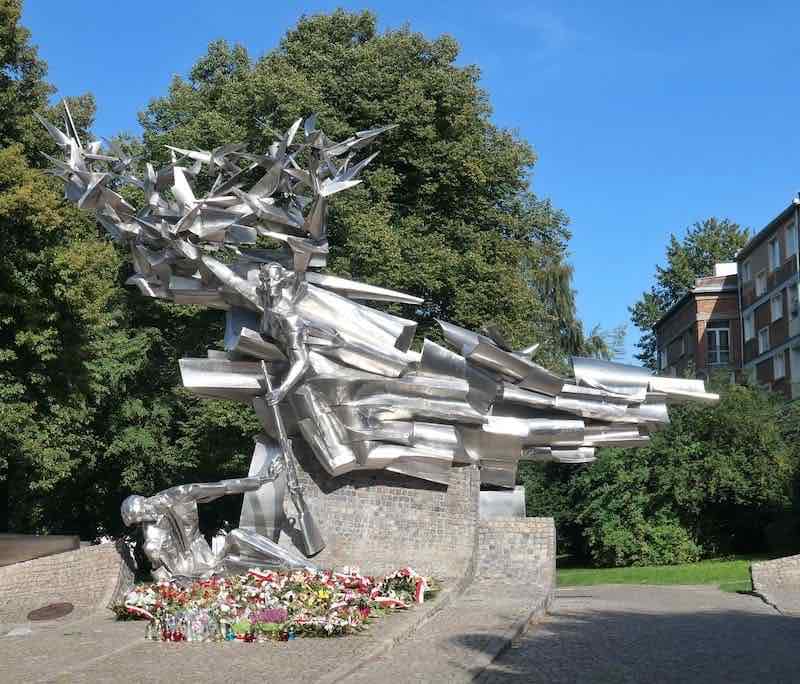
10. Shop at Market Hall
Gdańsk Market Hall (Hala Tagowa) was built in 1896. It has recently been completely renovated, leading to the discovery of the foundations of one of the city’s oldest churches, the 12th-century Church of St. Nicolas, underneath the main market building. Amid the cheap clothing stalls, rows of meat and dairy produce, local delicacies, and fresh produce, the church’s foundations have been left as they were found, providing a small, living archaeology museum in the basement along with a display of photographs, objects found during the excavations, and drawings of how the church might have looked.

11. Admire the Zuraw Crane
Serving as a testament to the city’s rich maritime and trading history, the impressive red-brick grandeur and colossal wooden lifting mechanism of the Zuraw Crane beside the Motława River once hoisted cargo onto ships during medieval times. Rebuilt after the war to become the oldest preserved port crane in Europe, it was once the largest working crane in the world, able to raise cargo to a height of 11 metres. The power came from men working beside two large wooden wheels. It’s now part of the National Maritime Museum.

12. Explore both sides of the Motława River
At the edge of the Old Town is the Motława River, a tributary of the Vistula River. The Promenade (Dlugie Pobrzeze or Long Embankment) hugs the river. It’s lined with a mix of red-brick buildings resembling Lego blocks, and several boat operators are moored beside the walkway.
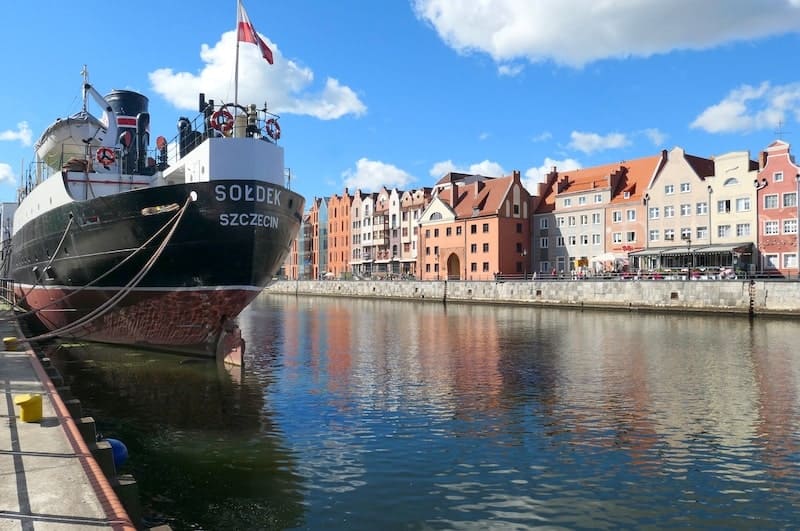
13. Cross to Granary Island
Once the site of 400 medieval granaries bombed during the war, the site is being redeveloped. It is connected to the riverside Embankment by pedestrian bridges, making it convenient to explore both sides of the Motława River. Each hour, the bridges are open to pedestrians for 25 minutes and ships for another 25 minutes, with 5 minutes in between to raise and lower the walkway.

14. Explore the area around the Love Bridge
Bread Bridge, the oldest in the city, dates to the 14th century. It is also known as Love Bridge because of the padlocks placed by lovers to symbolize their love and affection. The area is interesting to explore with the Radunia Canal, shaded paths, the magnificent Old Town Hall, and the impressive Grand Mill which houses the Amber Museum.
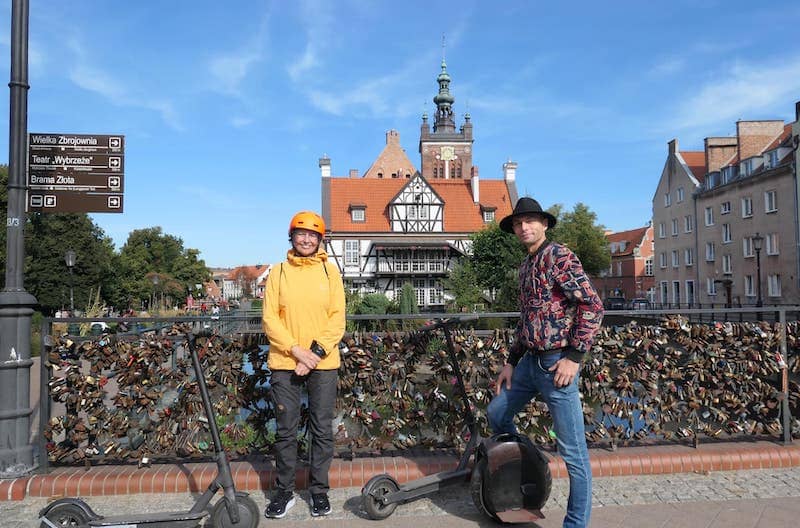
15. Tour the Zaspa murals
The Zaspa neighbourhood, dominated by Communist-era concrete buildings, has been beautified by murals painted during international competitions on over 60 buildings, some as tall as 12 storeys.
(ii) Inexpensive things to do in Gdansk
Compared to many European countries, Poland is a budget-friendly destination where food, transportation, and entrance fees are considerably cheaper.
16. Visit Gdańsk Town Hall for the museum and tower views
The Gdańsk Town Hall on Długi Targ (Long Market) is one of the most impressive buildings on the street, dating to the 15th century. Inside is the Gdańsk History Museum, which offers access to the beautiful interior and explores the town’s history through various exhibits on several floors. Climb to the top of the tower for superb views.

17. Spend time at the European Solidarity Centre
The European Solidarity Centre is a cutting-edge museum in a beautifully designed building on the edge of Gdańsk’s former Lenin Shipyard, where the ideas of solidarity were born, and the historic 1980 strike occurred. The rooftop garden offers lovely panoramic views of the shipyard.

Opened in 2014, the museum tells the story of Solidarność. This movement had a profound impact on shaping events that led to the dissolution of the Soviet Union, the fall of the Communist Bloc, the dismantling of the Berlin Wall in 1989, and the end of a divided Europe.
It profiles the protests at the Gdańsk Shipyard, the leadership of Lech Wałęsa, the historic agreement to establish independent self-governing trade unions in Poland, the influential papal visit of 1983, and the awarding of the Nobel Peace Prize to Lech Wałęsa in the same year. Exhibits describe the eventual free elections that generated overwhelming support for Solidarność and the election of Lech Wałęsa as Poland’s President in 1990.
Outside the shipyard is a memorial to the fallen workers of earlier 1970 protests.

What a fabulous museum with a superb audio guide! It had sensors that detected when I was in a particular location, leaving time for individual exploration of the exhibits. The museum has been awarded the European Heritage Label, which identifies sites that ‘have played an important role in European history and culture, and relate to the idea of uniting, as well as democratic and humanistic values of timeless significance.’
18. Tour Gdańsk Shipyard on a historical Polish boat
Tour the Gdańsk Shipyard in a replica of a small wooden boat used to move cargo in the past. Learn about the shipyard’s history and gain insights into the city’s maritime legacy while cruising along its waters.

The green cranes symbolic of the shipyard facilitate the building, repair, and loading of ships helping make Gdańsk Poland’s most important port.
Once a workplace for over 20,000 people, the Gdansk shipyards provide only 3,000 jobs today. The high price of steel has all but halted large shipbuilding projects. However, given Gdańsk’s skilled workforce and the port’s access to the Baltic (among other things), the construction of customized luxury catamarans is booming, with a waiting list of many folks with deep pockets.
19. Don’t miss the Museum of the Second World War
The relatively new (2017) state-of-the-art Museum of the Second World War follows the events of World War II that began on September 1, 1939, when Nazi Germany invaded Poland at the Westerplatte (not 10 kilometres from Gdańsk Old Town). At the time, Danzig was a free city governed by Poland under the terms of the Treaty of Versailles. Poland’s refusal to agree to Hitler’s demands to pass Danzig to Germany was used as provocation for a German invasion that precipitated World War II.
Besides the museum’s proximity to Westerplatte, Poland is a fitting location for a museum of this kind. Relative to its pre-war population, civilian casualties were higher in Poland than in any other country.
The war in Europe, based on the Polish experience, is a focal point. It’s the kind of museum that warrants several hours, if not visits; there’s so much to digest. I went twice, over a combined seven hours. The interactive exhibits and audio guide are excellent, and many are emotionally draining.

20. Take an electric scooter tour
Take a 90-minute budget-friendly adventure on an electric scooter tour of the Main Town and Old Town with Jakub of Segway Gdańsk Tours and Rental. Gain insights into Gdańsk’s rich history and cultural heritage while visiting many interesting sites.
21. Ride the AmberSky
The AmberSky Ferris Wheel, a smaller version of the London Eye, ascends to a height of 50 metres and offers superb views of the Old Town. It’s on Ołowianka Island behind the Polish Baltic Philharmonic in the former 19th century power plant building. The three-dimensional Gdansk sign is nearby.

22. Enjoy Polish delicacies

One of the best pierogi restaurants in Gdańsk is Pierogarnia Mandu, a popular sit-down place on a back street. There can be quite a wait for a table. It seems to appeal to locals, although the restaurant can be found on travel vlogs on YouTube, so it also attracts tourists. The lineup at Pierogarnia Mandu spoke to the quality and variety of pierogi.

Another popular restaurant is the Pyra Bar, which serves various potato dishes, including casseroles and pancakes. There are a limited number of tables if you choose to eat in, and several tables outdoors. Aim to be there outside the regular dining times to avoid a long line.
23. Visit the Amber Museum
With so many amber shops and stalls, amber seems very important to Gdańsk and its economy. Housed in the restored Grand Mill built in 1350 on the Radunia Canal, the Amber Museum tells the story of amber (or Baltic Gold).
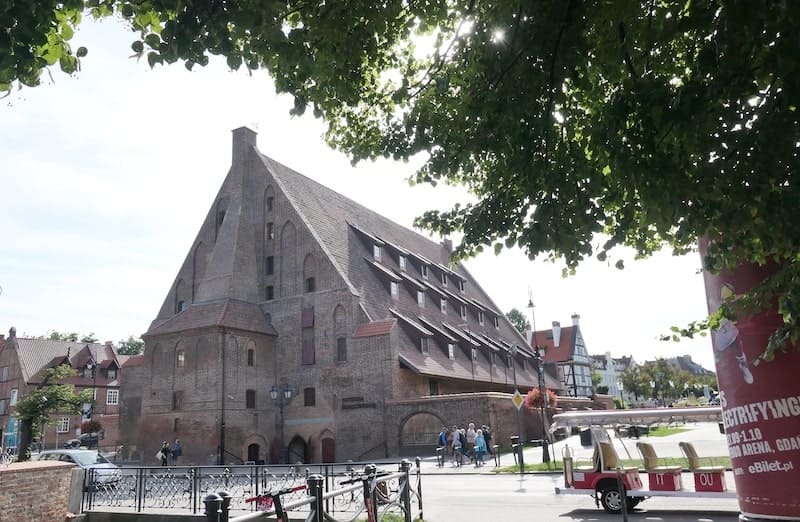
The museum profiles the origins of amber and extraction techniques. Poland has a longstanding relationship with this golden gemstone which originates in the resin of coniferous trees in the region. The largest source is found east of Gdańsk around the Kaliningrad enclave, and the combination of northeasterly winds and sea currents means that a lot of it washes onto the beaches around Gdańsk.
There are examples of amber inclusions (small plants or insects trapped in the resin), stunning amber jewellery, remarkable amber carvings, and amber-embellished furniture.
24. Visit Malbork Castle on a day trip
The region boasts several Teutonic castles, the most impressive being the fortified 13th-century Malbork Castle, built with 4.5 million bricks. A UNESCO World Heritage Site, it’s the largest in the world by surface area. The train from Gdańsk takes approximately 30 to 40 minutes.
A ticket includes an excellent audio guide to explore the castle at your chosen pace.
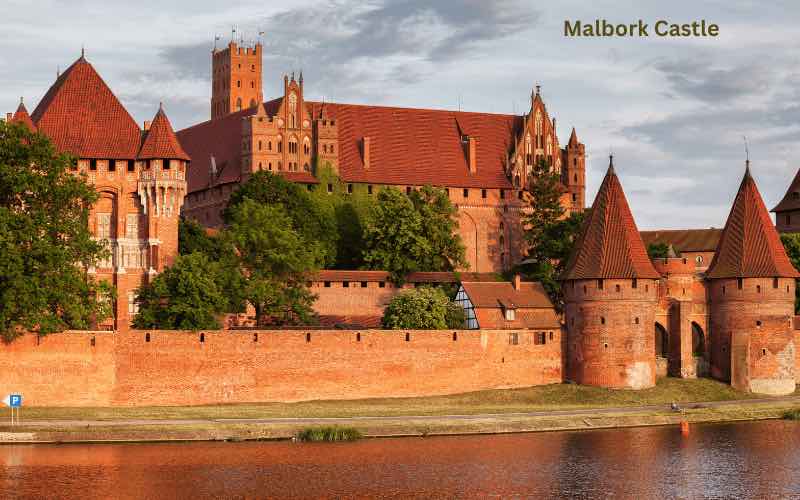
25. Take a day trip to Gdynia and Sopot
The Baltic coast towns of Gdynia and Sopot are easily accessible by train from Gdansk.
Opened in 2015, the Emigration Museum examines how, why, and to where over 20 million Poles have emigrated over the centuries. Poland is thought to have the sixth-largest diaspora in the world, and the Emigration Museum does an excellent job of explaining why so many Poles have emigrated over the years. Exhibits profile several prominent Poles who achieved excellence in their chosen fields.

Another interesting museum in Gydnia is the ORP ‘Błyskawica’ (Warship Lightning), which served the Allied forces during World War II. It’s considered the oldest existing destroyer of its kind in the world. It is the pride of the Polish fleet and took part in many wartime operations including the rescue of the encircled British forces in Dunkirk.
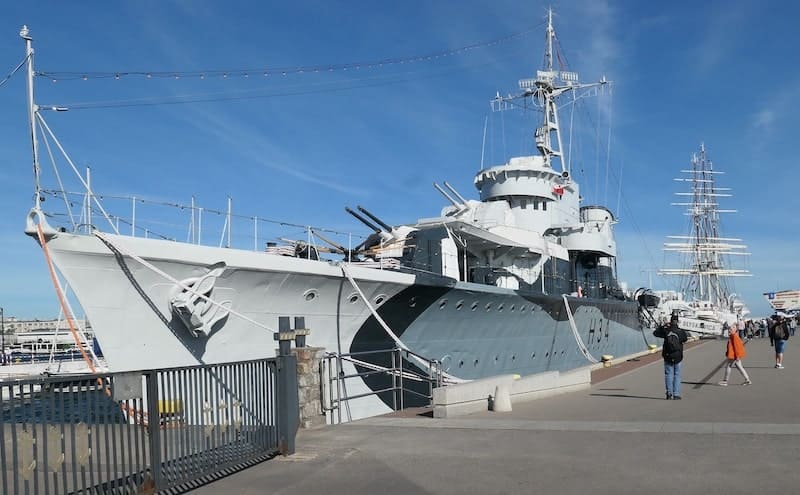
The seaside town of Sopot has a beautiful sandy beach and an impressive pier, the longest wooden pier in Europe. Stroll along the 4.5-kilometre fine-sand beach, walk along the pier (there’s a charge), take a harbour cruise, visit the Crooked House (Krzywy Domek), or enjoy a fresh seafood meal.

Sopot is only 20 minutes by train from Gdańsk. During the summer, you could catch the more expensive Gdańsk-Sopot ferry that takes an hour and ends at the Sopot pier.
Conclusion
Poland is one of the most underrated countries in Europe as an international destination for travellers. With its rich history, vibrant culture, beautiful scenery, and affordable prices, Poland has much to offer.
The Polish cities of Kraków, Warsaw, and Wrocław might attract more visitors, but Gdańsk is my favourite for its scenery, architecture, history, and world-class museums.
If you found this post helpful, please share it by selecting one or more social media buttons. Have you visited Gdańsk? If so, are there other budget-friendly things to do? Please share your thoughts in the comments. Thank you.
Pin for later?







Trackbacks/Pingbacks